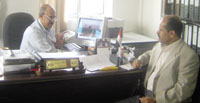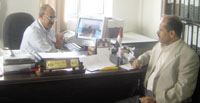
Sana’a sewage plant attempts to treat double its capacity every day [Archives:2008/1178/Health]
August 4 2008
 |
The Sana'a City Water and Sewage Treatment Plant has been treating water for agricultural use since its May 2000 inauguration. However, a recent crop of problems have appeared that jeopardize the plant's ability to treat water safely and effectively.
Located near Sana'a International Airport, the treatment plant consists of inflow screens, water pumps, dirt removal tanks, equipment to separate solids from liquid, aeration tanks, a chlorination unit and waste and surplus storage units.
British consulting firm Howard Humphreys designed the US $34 million plant to serve 500,000 residents with a daily inflow rate of 50,000 cubic meters.
The Yemen Times recently spoke with the plant's general manager, Hassan Zabarah, to hear about its important work and the problems it faces.
Tell us about the treatment plant's work.
The plant started operating on May 22, 2000. However, during its first five years, its work wasn't good. While its daily capacity is 50,000 cubic meters, employees were operating all of its units to treat only 24,000 cubic meters per day, which caused operational problems.
Now with population expansion, the plant currently receives 120,000 cubic meters per day. Although this poses a great challenge for the plant, it also faces problems because of this, but we can overcome them.
How does the treatment plant run and from where does it receive its funding?
The plant runs on electricity, with monthly operation costs between YR 25 and YR 27 million, whereas the cost is YR 15 million when it uses its own generators. We receive support from the National Water and Sanitation Authority. The plant also generates revenue for itself by selling water and surplus to farmers.
How does this sewage treatment plant benefit the public?
The plant separates incoming water, surplus and waste in an effort to clean the water for irrigation use. Many farms surrounding the treatment plant depend on this water for irrigation.
The plant also dries the surplus to sell as organic manure to nearby farmers and farms in Dhamar governorate. In this way, we save the clean water that people used for irrigation to be used for home consumption.
What about the purity of the water used for irrigation? Does it cause diseases?
The water's purity is 85 to 90 percent and harms neither people nor farms. In fact, most vegetables sold in Sana'a markets are fed on this water. If the water isn't clean, the produce is damaged.
How many employees are at the treatment plant?
We have 85 employees, including administrators, engineers, drivers, workers and guards.
Do employees receive any benefits other than their salaries?
Yes, they receive YR 7,000 each month and a liter of fresh milk daily, in addition to health services.
Do employees face any health problems or harm due to the nature of their work at the plant?
There are no major health problems. When there do happen to be any, they are simple, such as skin and abdominal diseases, which are easily cured. Plant administration pays the treatment costs for any employee who contracts such a disease or experiences any other type of bodily harm due to their work.
Does the plant plan to treat drinking water, like other plants in developed countries?
Our plant is designed for dual treatment, which cleans water to 90 percent purity for irrigation use only, whereas the other plants you mention are designed for triple treatment that purifies water 100 percent.
What problems does the sewage treatment plant face?
The plant faces five major problems, the first of which is vast population expansion, which heavily burdens our capacity. Although our capacity is 50,000 cubic meters, we receive more than double that every day and the number will only increase in the future.
A second problem involves solid wastes such as pieces of plastic and metal that people throw away in public bathrooms.
A third problem is oil and grease waste from vehicles because such wastes kill organic substances and bacteria that the plant runs on, which is the backbone of our work.
The fourth problem involves slaughterhouse waste, such as blood and animal hair.
Because blood's organic acid concentration is very high, it's difficult for the plant to process it, so we've asked slaughterhouses to work with us to avoid this problem.
A fifth problem is flooding from rains, but this isn't a huge problem because we can handle it by controlling the plant's gates. If such a problem does occur, the incoming waters change the treatment process. In this case, we get rid of the additional water in the nearby valley where it's used for irrigation. We have people who notify us of impending flooding, so we plug up the plant's gates to stop these waters.
Why don't you tell the public about these problems in order to help avoid them?
That's a good question and we're currently working on that. We initiated an awareness campaign on the back of National Water and Sanitation Authority's monthly bills. On these bills, we tell the public how to use water that's been purified. We also want media outlets to take a role in this as well.
You mentioned that population expansion is a burden upon the plant, so how will you seek to solve this problem?
The National Water and Sanitation Authority now is working on constructing another larger plant in the area of Bani Al-Hareth, to be completed by 2012.
While I can't disclose the specific details, I can say that this new plant's daily capacity will be three times larger at 150,000 cubic meters.
——
[archive-e:1178-v:16-y:2008-d:2008-08-04-p:health]


